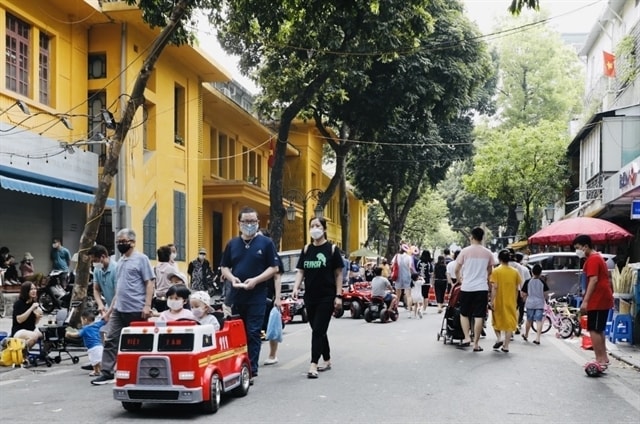Downgrading COVID-19 to Group-B infectious disease to change healthcare system
News - PublishedTime : 10:34, 08/06/2023

People on the walking street around the iconic Guom (Sword) Lake in Ha Noi
On Saturday, the National Steering Committee for COVID-19 Prevention and Control approved the downgrade in the classification of COVID-19.
Associate Professor Do Van Dung, who leads the Faculty of Public Health at the Ho Chi Minh city’s University of Medicine and Pharmacy, spoke to the Zing online newspaper regarding the implications of this downgrade. He said that, under the new Group-B categorisation, the Government will no longer be obliged to shoulder the main responsibility for patient treatment, which includes providing free treatment facilities and completely underwriting all medical costs.
Patients now have to pay for their medical expenses or the cost of vaccination, he said.
However, COVID-19 patients are no longer required to be quarantined. They will still be free to move around normally, he said.
Under the previous classification of COVID-19 as a Group-A infectious disease, citizens were obligated to adhere to stringent health safety regulations set by the Government. Such measures included mandatory testing, quarantine, and hospitalisation for infected individuals, underscoring the profound threat the disease posed to public health, its high potential for transmission, and associated mortality, Associate Professor Do Van Dung said.
Associate Professor Tran Dac Phu, former head of the General Department of Preventive Medicine, pointed out that diseases categorised under Group B do not qualify for free treatment, according to current law.
He suggested that, with the reclassification, authorities need to reassess the financial implications of this shift. Professor Tran stressed the need for the government to contemplate permitting health insurance to absorb the costs of COVID-19-related medical expenses. He highlighted the relevance of this consideration, given the significant percentage of the population covered by health insurance.
Plan for the new period
Professor Phu said the Ministry of Health is advised to issue a specific plan for vaccination against COVID-19 shortly.
“The ministry should regulate who is obligated to receive the vaccine, those for whom it is recommended, who will be given vaccinations for free and who has to pay,” he said.
He said the World Health Organisation recommends that countries be cautious and switch from urgent COVID-19 pandemic prevention and control to a sustainable and long-term control strategy.
Therefore, Vietnam needs to issue appropriate policies and plans to prevent and control COVID-19.
It aims to both closely monitor the pandemic situation for an appropriate response and control the pandemic in every situation in an inexpensive way but still protect the health and interests of the people, he said.
Dung said at this time, wearing masks is no longer mandatory. However, he still encouraged people to obey the ministry’s 2K messages – Khau trang (Mask) and Khu khuan (Disinfection) to protect their health.
Everyone should wear a mask when going to crowded and high-risk places and maintain the habit of washing hands to avoid infectious diseases, he said.
Associate Professor Nguyen Viet Hung, deputy head of the Ha Noi Association for Infection Control, also said that the most appropriate measure at this time is following the 2K message.
He said Vietnam is located in a tropical climate, where there are many infectious diseases. Thus, people's awareness is believed to be very important in preventing these diseases, he said.
Mild symptoms
Phu said the COVID-19 pandemic in Vietnam has been controlled.
Most new COVID-19 cases have mild symptoms or no symptoms, and do not result in overloading of the healthcare system, he said.
Severe and fatal cases are mostly found in people with underlying diseases, unvaccinated and immuno-compromised people or the elderly, he said.
"These cases can be severe if infected with any other infectious disease virus such as influenza, not just SARS-CoV-2," he added.
Dũng said currently, the number of new COVID-19 cases recorded in the country is at a low level. The mortality rate is also lower than other diseases such as tuberculosis and pneumonia.
Vietnam has already experienced the peak of the pandemic. The country now has a high vaccination rate, most people strictly follow regulations on pandemic prevention and control, he said.
"So, the situation of the pandemic is the country is not worrying," he said.
Hung said: “Current COVID-19 symptoms are very mild, possibly like a common cold.”
Most severe patients appeared in the early stages of the pandemic, when the highly-virulent Delta variant predominated, and the coverage rate for people at risk was not high, he said.
Now, the Omicron strain and its variants are dominant. He said this strain has negligible virulence and mild symptoms, mainly attacking the upper respiratory tract.
Symptoms of infection are like the seasonal flu, he said.
Statistics from the health ministry showed that from the beginning of this year to May 29, the country recorded 85,493 new cases of COVID-19.
The monthly average number of new cases is 17,000, about 48 times lower than in 2022 and 8.5 times lower than in 2021.
There were only 20 deaths due to COVID-19, and the mortality rate dropped sharply to 0.02 per cent. The fatal cases are all patients with underlying diseases or who have not been vaccinated.
VNS
